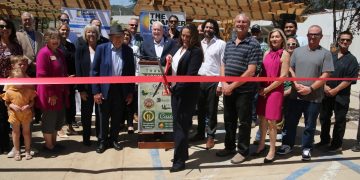
A map of San Diego parceled out by ZIP codes and color-coded shows a clear delineation distinguishing certain parts of the city from others. It could illustrate any number of things: socioeconomic status, population per square mile, level of household education. The colors bleed from a dark red in most areas in the north and west of the city to a pale yellow in the south and east — a fairly common pattern found in many of the data collected by the U.S. Census Bureau. This map, however, depicts something the Census doesn’t measure. It tracks the amount of solar installations per 1,000 people, and it was crafted by the Environmental Health Coalition (EHC) as a way of understanding what San Diego’s solar profile looks like — and how it could look better. Kayla Race, a policy advocate for EHC’s Green Energy/Green Jobs campaign who lives in La Jolla, said she is encouraged by what she sees when she looks around at rooftops in her community: a smattering of solar panels pumping renewable energy into the homes and businesses on which they sit. The fact that La Jolla enjoys a deeper red hue than many other ZIP codes on the EHC’s solar map isn’t really surprising. After all, it’s an affluent coastal community whose residents tend to care about the health of their immediate environment and who have the means to explore the latest technology in clean energy. What is surprising is that, even given its place near the top of per capita solar installations, La Jolla is still only taking advantage of roughly 8 percent of its solar potential. The city as a whole, meanwhile, only uses about 3 percent of its solar capability, according to what SDG&E estimates is possible. “Even for the amount of solar La Jolla has, there’s still a huge potential for growth with rooftop solar,” Race said. “As a region, there’s even more room for growth. We have so much more potential for clean energy.” The fact that we’re not living up to our potential isn’t entirely the fault of citizens, Race said. The city and utility companies don’t always cut a clear path for residents to go solar. “There are a lot of things that the city and utilities could be doing to procure more clean energy, especially in local urban areas where there’s a dearth of it,” Race said, noting that AB 1990 — a state bill dubbed “Solar for All” that would have provided a set financing source for urban large-scale rooftop solar — was shot down earlier this year after extensive lobbying by utility companies. “The utilities really fought [AB 1990],” she said. “They’re resistant to bringing in more solar because it goes against their whole model. They’re using an archaic system of large, dirty power plants, and they’re having trouble transitioning and figuring out how to have success in an energy-efficient future. It’s like they’re using vinyl records in iPod generation. But it’s certainly a tricky thing to get them on board, when we’re still figuring it out ourselves.” So just exactly how does Race think organizations like EHC can get public utilities on board? “We’re working with a number of groups in collaboration, like the California Environmental Justice Alliance (CEJA), to see how we can bring more solar and energy efficiency in, particularly in low-income communities,” she said. It’s not an easy task, but EHC recently won a coup with the Public Utilities Commission’s approval of EHC’s recommendations for energy efficient programs earlier this month. The recommendations include things like collaboration efforts between utilities and EHC to devise behavior education programs designed after the nonprofit’s past successes; doubling the number of middle-income families that have access to free energy efficiency; setting higher goals for state energy efficiency upgrade programs; and developing more energy-efficiency related jobs through education and training. Perhaps most importantly, EHC and CEJA are working toward implementing programs that make it easier for families in lower-income neighborhoods to use solar. And though some may think a world where every home has rooftop solar panels is a futuristic dream, the reality shouldn’t be so far-fetched, Race said. “Solar is becoming exponentially cheaper every year. We’ve seen a dramatic drop in prices over last 10 years, and I see that trend continuing,” she said. “It’s becoming a more feasible option as we see more financing options, like a solar-leasing model. We’re still not seeing it coming into low-income neighborhoods, so it’s still not affordable there yet, but a clean energy future will happen in this lifetime. Continuing on the path of finite resources of energy, like coal, oil and natural gas is a very shortsighted solution. We could be getting energy from totally clean, infinite resources. The technology is here now.” Some might ask why they should care about increasing solar in other communities. After all, La Jolla is on the higher end of San Diego’s solar scale, so why put in the effort when it’s clearly ahead of the game? “I think some in La Jolla might say, ‘I’m a homeowner, I have solar, so I’ve done my part. Why should I care that others have it?’ The fact is that air pollution doesn’t stop at community borders,” Race said. “If SDG&E threatens one community with proposals for new dirty energy, it affects the whole region. If we’re not doing all we can to maximize clean air, we all feel it. We’re all in this together.” For more information about EHC’s solar initiatives, visit www.environmentalhealth.org.













Discussion about this post